
Esta obra está bajo una Licencia Creative Commons Atribución-NoComercial-SinDerivadas 2.5 Argentina
RELATIONSHIP BETWEEN THE SOCIOECONOMIC, SOCIODEMOGRAPHIC AND BTL PUBLICITY FACTORS IN THE INCIDENCE OF CHILDHOOD OBESITY IN CUENCA-ECUADOR
Marco Antonio Ríos Ponce, Juan Francisco Álvarez Valencia, Joffre Sebastián Arteaga Huiracocha, Diana Carolina Arízaga Toledo
_________________________________________________________________________________________________________________________________________________________________________
Relationship between the socioeconomic, sociodemographic and BTL publicity factors in the incidence of childhood obesity in Cuenca-Ecuador
Marco Antonio Ríos Ponce
Facultad Ciencias de la Administración
Universidad del Azuay
Cuenca-Azuay-Ecuador
mrios@uazuay.edu.ec
Juan Francisco Álvarez Valencia
Facultad Ciencias de la Administración
Universidad del Azuay
Cuenca-Azuay-Ecuador
falvarez@uazuay.edu.ec
Diana Carolina Arízaga Toledo
Facultad Ciencias de la Administración
Universidad del Azuay
Cuenca-Azuay-Ecuador
dianacaroarizagat@yahoo.com
Joffre Sebastián Arteaga Huiracocha
Facultad Ciencias de la Administración
Universidad del Azuay
Cuenca-Azuay-Ecuador
arteagasebastian32@gmail.com
Reception Date: 05/03/2018 - Approval Date: 06/30/2018
ABSTRACT
An exploratory-descriptive research was developed to determine the influence that BTL, advertising and electronic media had on children and their parents when choosing food products. Two research methods were applied. A qualitative research gathered information through focus group, interviews with experts and interviews. Then, a quantitative research was carried out through surveys applied to parents of overweight children. Finally, the data was proessed and the socio-economic and socio-demographic results were obtained. This information allowed to identify the behavior of the families in Cuenca-Ecuador.
KEY WORDS: Social Marketing; Advertising; Below the Line; Childhood Obesity; Communication.
INTRODUCTION
Research, write and talk about marketing can be more complicated than it seems, because it has great trajectory through history because the marketing existed from almost the beginning of humanity. The origin of the word Marketing, comes from the United States, although it is not known exactly who was the creator of this word and neither the year in which it began to be used, there are different speculations about its origin, but it is known that this term refers to studying and applying different strategies to obtain an effective commercialization of goods and services in a specific market. Marketing has evolved thanks to the creation of different means of communication such as: printing, radio and television (ATL), but this has not been enough, so, nowadays, marketing strategies are perfected with the strategies of BTL (Below The Line) and the advancement of technology, where it no longer focuses on the product but on the value of people.
Marketing is a way of organizing a set of actions and processes when creating a product to create, communicate and deliver value to customers and to manage relationships; Its purpose is to benefit the organization by satisfying customers (American Marekting Association, 2013).
Childhood obesity is a controversial issue that has been treated worldwide, so the World Health Organization - WHO - (World Health Organization, 2016) defines "Overweight and obesity as an abnormal accumulation or excessive fat that poses a risk to health. " According to data from the National Health and Nutrition Survey (Freire & Ramírez), in Ecuador it is recorded that between the age of 5 to 11 years, the obesity index triples reaching 29.9%.
The objective of the research is to identify if there is a correlation between BTL advertising and childhood obesity in the city of Cuenca, the reasons for this disease in the city, the stimuli of purchase decisions in the representatives of children between a range of age from 5 to 11 years and variables of consumption, for which a qualitative and quantitative research will be carried out to know about the topic and be able to obtain coherent results about obesity.
DEVELOPMENT
Methodology
An exploratory - descriptive investigation was carried out, which consisted in knowing the predominant behaviors of the consumers through the description of their activities and decision process. Qualitative research and quantitative research: two types of research were applied.
Phase 1: Qualitative research
Data collection techniques were used, such as: interviews with three different types of experts. For this study, experts in marketing, nutrition and paediatricians were considered to find out their opinion on the nutritional and advertising factors that affect child obesity; A focus group of 12 parents and representatives of the age between 27 to 40 years of age who have children aged 5 to 11 years was developed, to know the food, the influence that BTL advertising has and the forms of entertainment that they have. their children; In-depth interviews with four parents of the same characteristics as the participants in the focus group, where they discussed the feeding of children in their homes and the possible influence of BTL advertising on infants, the hobbies of children, government programs and policies to eradicate childhood obesity. All the qualitative research gathered many important topics to get to know where the problem of childhood obesity lies and to be able to continue with the quantitative research, to make the report of this phase 1 was based on the ATLAS TI software.
Fase 2: Quantitative research
A convenience sampling was conducted, taking 300 households from the city of Cuenca U rbana as a reference for childhood obesity so that the research is meaningful. It should be emphasized that convenience sampling is a non-probabilistic sampling, "the choice of elements does not depend on the probability but on the causes related to the characteristics of the research or who makes the sample"(Hernández Sampieri & Fernández Collado, 2006, page 241) , where people are selected depending on the accessibility and availability of the researchers.
4,500 surveys were sent to families with children between 5 and 11 years of age in the city of Cuenca through fiscal, private and fiscomisional schools; as this survey was not mandatory, 2,500 answered, of which 300 surveys were effective for the investigation. P ara considered effective had to answer the question affirmatively filter if you had some degree of overweight and childhood obesity.
The procedure and statistical data analysis was carried out with the help of the IBM SPSS Statistics version 23 program and the results were presented in dynamic tables for better understanding.
Content development
The accessibility that people have to information of all kinds makes their eating habits change constantly, because BTL advertising is launching new products constantly and convincing people that they are getting better, so it radically changes the style of families and it is part of a culture to eat processed foods that go straight to the table. It is impressive all the knowledge that people have about the different types of foods that are offered in the market, however, even though they know what are the good and bad foods, it is observed that all the people inside and outside their home They have a very varied diet of foods that are both nutritious with protein and other foods high in fat, combining them constantly without having good results for the future.
The nutrition of people is very ingrained with the socioeconomic level and the education they have; The first is that while the economic income per family is lower, their nutrition is less nutritious and balanced. Today we see advertising around s side s, very striking, particularly foods like snacks, fast food, sugary juices, soft drinks, etc. that ends up convincing from the parents to the smallest ones for the immediate consumption and consequently come the alimentary changes; because if the purchased foods come to like the child, the parents will buy it frequently.
These dietary changes that people, come n s given by several factors that gradually make people consume products that are harmful to your health. One of the main factors is sedentary lifestyle, this issue is of great concern because it is due to the excessive use of computers and cell phones, but that is not all. Many food companies seek to generate sales constantly, therefore, develop any type of advertising campaign to offer a product that is made with components that meet the minimum requirements to be marketed within the country. When developing strategies for effective communication in electronic media such as social networks, web pages, applications and also advertising on the streets of the city offering a product that is harmful to the health of people, it is not being carried out a social responsibility, but the company focuses clearly on the economic benefit.
Another very important factor is time, both parents and mothers have locked jos full time, whats forced to buy products that are easy to cook in less time, or, buy food and made only for the immediate consumption. According to parents, soft drinks are the main product that causes childhood overweight and obesity, because they are products with greater accessibility to all people, they can be found anywhere and also prefer to cool off. In addition to sugary drinks there is also a large consumption of sweets by children, which also have a high content of processed sugars and are acquired especially for their shape, presentation and price, which are attractive for both parents and children.
Finally, it is observed that the efforts of the Government have not been fully effective despite the fact that new norms have been implemented to which companies have had to adapt to sell their products in Ecuador, so companies should have a greater social responsibility focused on the health of the people, especially children. Hese social marketing campaigns can help people who do not have much information about nutrition and make them aware so that they can change their eating habits that affect their future health.
The Government has generated some control over the foods and products sold within the educational establishments, in this case, the control of the bars that have expanded their menu with more nutritious products and at the same time eliminating other products that are really harmful for A child's health, they are high in fat.
The idea of the semaforización of the products is a good initiative so that people can be more careful in the selection of products, however, there are flaws in this concept, since people can get to prioritize certain products with components that do not they help the child's growth by substituting other products that complement the child's life with a balanced and nutritious diet.
Qualitative research
The most relevant results of the different interventions are shown to experts in marketing, nutrition and pediatrics with respect to the subject of study, through an analysis in the ATLAS.ti Software.

Graph N ° 1. Cloud ATLAS.ti Marketing Experts
Source: Own Elaboration
Marketing experts say:
-
Marketing is to generate value and satisfaction.
-
The different marketing strategies must respond to an ethical code.
-
Representatives must set limits on the consumption of certain products.
-
There is a co-responsibility between parents and companies for adequately responding to the needs of children.

Graphic No. 2: Cloud ATLAS.ti Expert Committee on Nutrition
Source: Own Elaboration
Nutritionists analyze and indicate that:
Globalization causes changes in the consumption habits of people.
-
Children spend less and less time in outdoor activities.
-
Increase in products with high hypercaloric contents and easy access for children.
-
The habits that your family nucleus has will directly affect your physical and mental health.
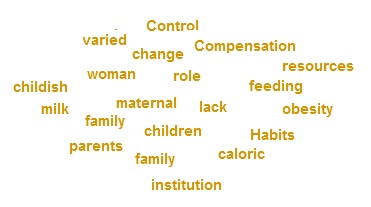
Graphic No. 3: Cloud ATLAS.ti Experts Pediatrics
Source: Own Elaboration
The pediatricians state that:
-
Reduces the control of children with the insertion of women in the workplace.
-
Parents should not compensate their children with hypocaloric foods.
-
Families are fed according to their knowledge and economic possibilities.
-
Family habits affect the child's food preferences.
-
Routines should be established as well as limits on what your children may or may not eat.
Frequency tables:
Table N° 1. Civil Status of the representative

Source: Arízaga and Arteaga (2018)
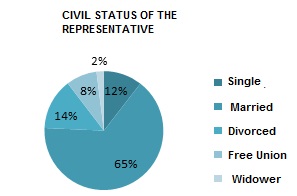
Figure N ° 1. Civil Status of the representative
Source: Arízaga and Arteaga (2018)
Table N° 2. Level of Instruction of the representative

Source: Arízaga and Arteaga (2018)
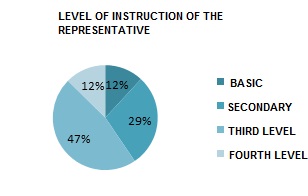
Figure N ° 2. Level of instruction of the representative
Source: Arízaga and Arteaga (2018)
Table N° 3. Age of the Child

Source: Arízaga and Arteaga (2018)
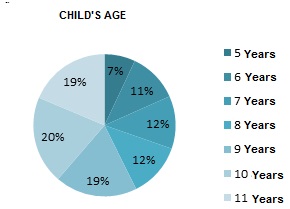
Figure N° 3. Age of the child
Source: Arízaga and Arteaga (2018)
Table N° 4. Households with Internet

Source: Arízaga and Arteaga (2018)
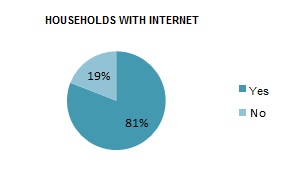
Figure N0 4. There is internet service in the home
Source: Arízaga and Arteaga (2018)
Table N° 5. Homes with electronic games
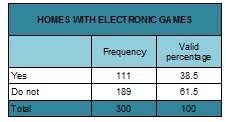
Source: Arízaga and Arteaga (2018)

Figure N° 5. Homes with Electronic Games
Source: Arízaga and Arteaga (2018)
Table N° 6. Total Household Income
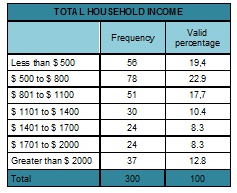
Source: Arízaga and Arteaga (2018)

Figure N° 6. Total household income
Source: Arízaga and Arteaga (2018)
Table N° 7. Medical diagnosis of the child
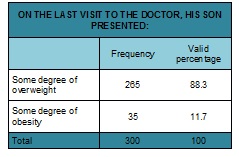
Source: Arízaga and Arteaga (2018)

Figure N ° 7. Diagnosis of a doctor about the child
Source: Arízaga and Arteaga (2018)
Table N0 8. Accessibility of the child to electronic media

Source: Arízaga and Arteaga (2018)

Figure N° 8. Accessibility of the child to electronic media
Source: Arízaga and Arteaga (2018)
Table N° 9. Hours of electronic entertainment of the child per day
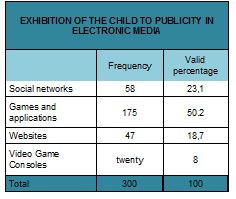
Source: Arízaga and Arteaga (2018)

Figure N ° 9. Hours of electronic entertainment of the child per day
Source: Arízaga and Arteaga (2018)
Table N° 10. Greater impact of advertising for the child

Source: Arízaga and Arteaga (2018)

Figure N° 10. Greater impact of advertising for the child
Source: Arízaga and Arteaga (2018)
Table N0 11. Invasion of technology in green spaces for children

Source: Arízaga and Arteaga (2018)

Figure N0 11. Invasion of technology in green spaces for children
Source: Arízaga and Arteaga (2018)
Table N0 12. Hours of electronic entertainment of the child per day

Source: Arízaga and Arteaga (2018)

Figure N0 12. Electronic Entertainment Hours
of the child a day
Source: Arízaga and Arteaga (2018)
Conclusions of the frequency tables
It is necessary to take into account the main factors that cause childhood obesity, identifying in the first instance the knowledge of parents and representatives in the subject, who are generally responsible for guiding the nutrition and food of children. Each adult or delegate is responsible for the amount of healthy food or food that the child must eat. For what could be determined, based on interview research, that many of the parents are not well informed or trained about the different types of food that children need daily. For that reason, a fundamental actor to control child obesity in a better way is the government. It is necessary to establish policies and regulations inside and outside schools. Despite the fact that some of them have already been finalized and implemented, we can observe an increase of this disease in children, which means that there is no controlled follow-up of both the government and the parents or representatives.
It is important that the main actors can control advertising and excessive use of electronic media that bring all kinds of advertising and among them, the poor diet with images and videos of food high in fat and calories.
Dynamic tables
Table N ° 13. Children who have electronic games in their home with respect to the hours they dedicate to entertainment
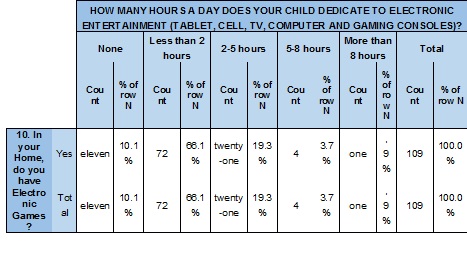
Source: Arízaga and Arteaga (2018)
The analysis of the table is made based on the electronic games that the child has in his home and the relation with the hours that the child dedicates to electronic entertainment. As shown in the table, 66.1% of children usually spend up to 2 hours in this type of entertainment, while in second place, with 19.3%, there are children who spend 2 to 5 hours in the same type of electronic entertainment. It is important to know this type of analysis since, based on interviews with experts, they comment that children currently spend more time at home playing with electronic devices than in other places that could be more recreational and healthier.
It is known that the hours a child can spend indoors playing with electronic devices can be one of the main causes for obesity, since the child stops doing all kinds of physical activity without knowing what the possible problems are. In the health. This study is closely related to today's technology and how advertising incurs in the minds of children.
Impact of advertising on children with respect to some degree of overweight and obesity detected by the doctor
Table N ° 14. Impact of advertising on children with respect to some degree of overweight and obesity detected by the doctor

Source: Arízaga and Arteaga (2018)
The relationship that is presented in the table, about some degree of obesity and the impact that advertising has on the child, is of vital importance. Many children are directly influenced by the pu-blicity that enters their eyes; When you constantly observe some type of billboard, it gets to position itself in your mind. For this reason, it is necessary to identify if this type of advertising affects the development of chronic diseases such as overweight and childhood obesity, which reduce the lives of people.
By identifying some degree of overweight, it is determined that it can be mainly given by the advertising that is on the billboards with 90.2% incidence in children, but also in the same category of billboards can affect a 9.8% of children who may have some degree of childhood obesity. As we can analyze, the degree of overweight that a child can have due to the influence of billboards is a majority level than that of obesity.
Invasion of the technology in the green spaces and the electronic entertainment hours of the child
Table N ° 15. Invasion of technology in green spaces and hours
of retainment ent child's electronic
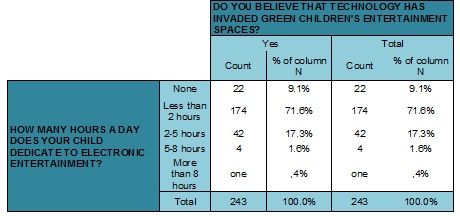
Source: Arízaga and Arteaga (2018)
The results prove that, of the people surveyed, 71.6% think that their children spend up to 2 hours in this type of technological entertainment. Following this first group, we have 17.3% that represents children who spend 2 to 5 hours in the same type of technological entertainment instead of other spaces outside the home. These two percentages are the ones that have the most relevance in the researchand show us that there really is a replacement in the green points and in the lifestyles of the people. These percentages become alarming, because one can appreciate the absenteeism of parents on a daily basis as they have very little knowledge of what children do in their free time.
Finally, after having analyzed the variables, we can determine that there is a close relationship in the invasion of technology in green spaces and the hours that children spend n entertained in technology, you can clearly see this replacement and changes of habits. The experts in children recommend that they have other activities outside the home and away from technology, with healthy foods for proper nutrition. As mentioned in the interview with experts, pediatricians and nutritionists interviewed talk with parents constantly so that their children have a better quality of life in the present and especially in the future.
Electronic means that the child is more exposed to publicity regarding visits to the doctor the child prsenta some degree of overweight
Table No. 16. Electronic means that the child is more exposed to publicity regarding visits to the doctor the child some degree of overweight
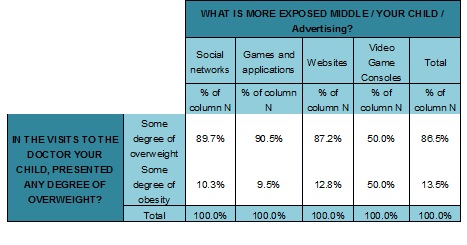
Source: Arízaga and Arteaga (2018)
In the present table, it is necessary to analyze which are the electronic means to which a child is more exposed each day and also, this can be related to some degree of overweight or childhood obesity. According to the interview with experts, children are currently involved or exposed too much to the advertising that is found in social networks, games, applications, websites and video game consoles, which can be one of the main factors that cause overweight and obesity at an early age.
Similarly, we can analyze this table by categories, identifying the most important for the study; First, we have the category of games and applications, because it is the one with the highest percentage with 90.5% of representatives have indicated that this same category occurs in children some degree of overweight and the difference is d 9.5% present some degree of childhood obesity. That is to say, that in its entirety it generates a lot of sedentary lifestyle.
Impact that the child has in BTL media with respect to the age of the same
Table N ° 17. Impact that the child has in BTL media with respect to the age of the same
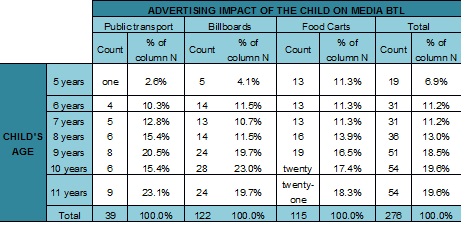
Source: Arízaga and Arteaga (2018)
The advertising impact in different BTL media such as public transport, billboards and food carts can have an influence according to age between 5 to 11 years, so in the table you can see that 23.1% of children / a 11 years old calls attention to the publicity that is exposed in public transport such as buses, taxis, among others. While 10-year-old children focus on billboard advertising where they can observe different types of non-nutritional food campaigns, which when recorded in the mind of the child can change the decision to purchase products of the same category.
Finally, children of 5 years are exposed to advertising on food carts such as ice cream carts, hot dogs, hamburgers, among others, reason why they encourage the decision of immediate purchase of very unhealthy food for their organism and that could generate diseases such as childhood obesity or overweight.
CONCLUSION
The surveys were sent to 4,500 representatives among fiscal, private and fiscomisionadas schools, but returned 2,500 because it was optional. only 300 surveys were effective for the project, and this number 216 were answered by representatives of private schools, 19 public and 65 fiscomisionadas schools, so you can see the layout and interest among the various reference groups. Of the 300 surveys, 47% of them have a level of instruction of third level, so with this information collected you can obtain relevant data on the customs that families in the city of Cuenca may have.
An achievement for the research is that it can analyze children between 5 to 11 years old, but with an approximate number of boys and girls who represent a similar percentage. Something important in this investigation is the internet service that the home has, since many of the electronic media such as the Tablet, the cell phone, video game console and the computer need these tools to be able to function correctly, but above all use them efficiently, since there are endless applications that children like and spend a lot of their time in these activities.
A fundamental factor that causes childhood obesity is the fact that the child does not have enough physical activity for their age, so thanks to the research of frequency tables we can see that 57.35% of infants they do not carry out physical activity outside of their class hours, which directly influences their weight gain and thus their childhood obesity.
The accessibility of children to electronic media is unimaginable, so thanks to the research it was observed that the most accessible medium for children is the computer, because there they find games, web pages, applications, among others and the child is willing to spend your time in this medium.
By crossing variables such as accessibility of electronic media that the child has and with whom he spends his free time, the necessary results were obtained for the identification of the behavior of parents and children inside the house and it has even been possible to determine how they act outside of the home. She, by what shows that many times the child is overweight or obese child being cared for by their parents.
It is known that 66.1% of children are deeply immersed in technology, which often causes them to spend whole hours playing on the Internet and looking for different types of information, either for entertainment or academically, which is why it is a cause principal that children have stopped going out to play in green and recreational areas, and that this influences the overweight they may have.
One of the major efforts that the government has made is the signaling of all the edible products, so variables were crossed to see how much this new information influenced the purchasing decision of the representatives, and their results were that the 78.8% of people choose better healthy foods for children and the whole family.
In conclusion, electronic media and advertising BTL influence greatly in the purchase decision of a child and his / her representative, the s electronic devices have plenty of room for children in a range of 11 to 5 years old so They are very susceptible to that kind of unconventional advertising. It generates a higher percentage of overweight and not of childhood obesity, so this may be the factor for future generations to trigger this disease, as it is unfortunately only a matter of time.
REFERENCES
Please refer to articles in Spanish Bibliography.
BIBLIOGRAPHCIAL ABSTRACT
Please refer to articles Spanish Biographical abstract.
































